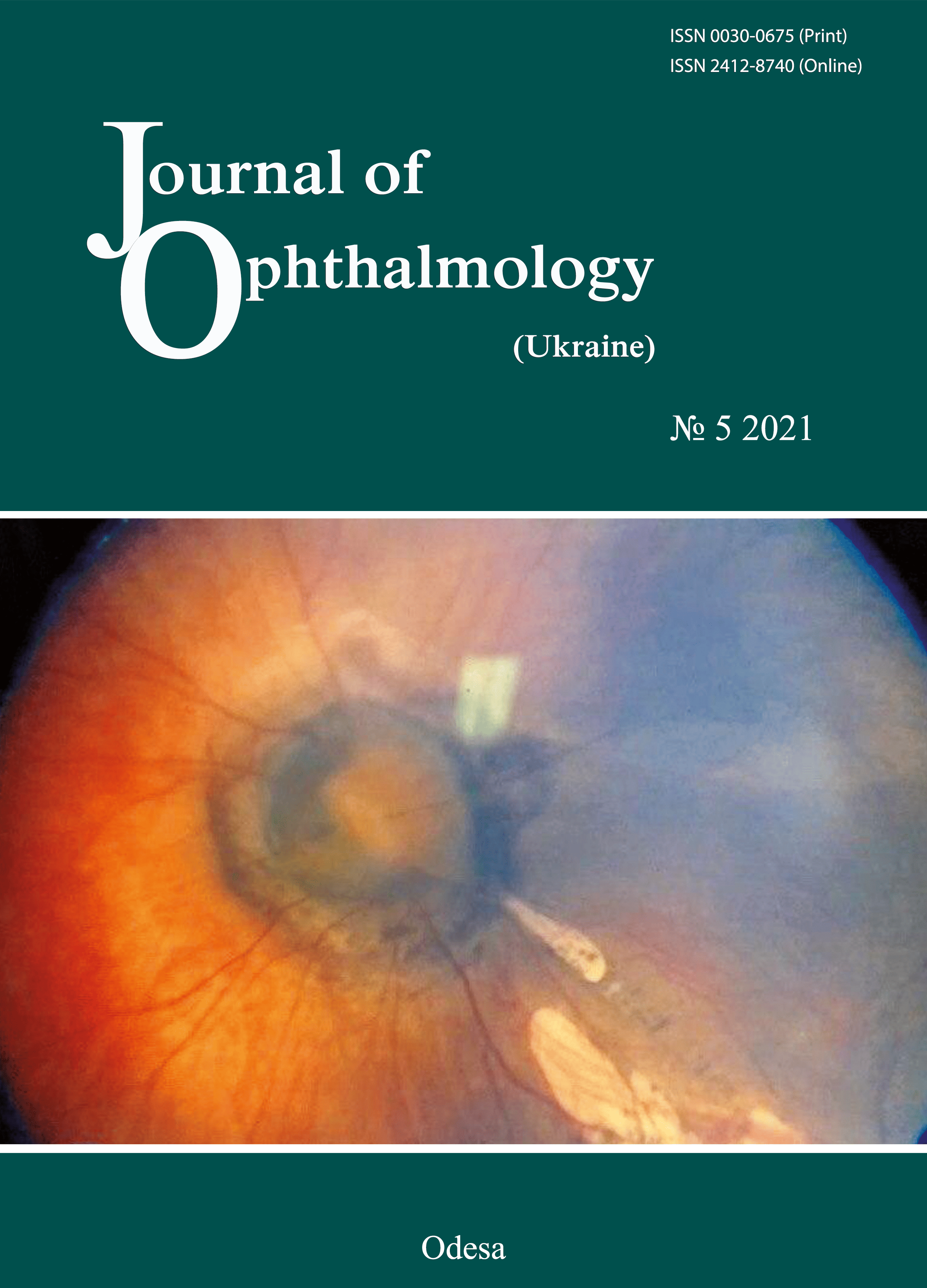Evaluation of corneal distortion characteristics in different eyes using Scheimpflug camera device
DOI:
https://doi.org/10.31288/oftalmolzh202151420Ключові слова:
сorneal deformation, corneal crosslinking, Corvis ST, keratoconus, refractive surgeryАнотація
Objective. To study the correlations between corneal distortion and morphological features in different kinds of eyes such as healthy ones (HE), ones previously undergone myopic PRK (PRKE), ones affected by keratoconus (KCE) and keratoconus eyes previously undergone corneal collagen crosslinking (CCCE).
Materials and Methods. In this retrospective comparative study, a total of 106 HE of 106 patients, 58 PRKE of 58 patients, 33 KCE of 33 patients, 28 CCCE of 28 patients were included. A complete examination of all eyes was followed by tomographic (Pentacam, Oculus, Wetzlar, Germany) and biomechanical (Corvis ST, Oculus, Wetzlar, Germany) evaluation. Differences among Corvis ST (CST) parameters in the different groups have been analyzed. Linear regressions between central corneal thickness (CCT), intraocular pressure (IOP) and anterior corneal curvature measured with Simulated Keratometry (SK), versus corneal deformation parameters measured with Corvis ST in the different groups, have been run using SPSS software version 18.0.
Results, HE showed a significant correlation between main curvature power of the cornea within the central 3 mm expressed in Diopters (KM) and 6 CST parameters; between CCT and 4 CST parameters and between IOP and 5 CST parameters. PRKE showed a significant correlation between KM and 3 CST parameters; between IOP and 4 CST parameters and none between CCT and CST parameters. KCE showed a significant correlation between SK and 3 CST parameters; between IOP and 3 CST parameters and none between CCT and CST parameters. CCCE showed a significant correlation between KM and 5 CST parameters; between CCT and 1 CST parameters and between IOP and 5 CST parameters.
Discussion. Data of this study suggest that both corneal curvature and IOP could have a greater influence on the corneal deformation, compared to central corneal thickness (CCT). These results should be taken into account by further studies aiming to assess biomechanical corneal characteristics.
Посилання
1.Luce DA. Determining in vivo biomechanical properties of the cornea with an ocular response analyzer. Journal of Cataract and Refractive Surgery. 2005;(31):156-162. https://doi.org/10.1016/j.jcrs.2004.10.044
2.Martinez-de-la-Casa JM, Garcia-Feijoo J, Fernandez-Vidal A, Mendez-Hernandez C, Garcia-Sanchez J. Ocular Response Analyzer versus Goldmann Applanation Tonometry for Intraocular Pressure Measurements. Investigative Ophthalmology & Visual Science. 2006;(47):4410-4414.https://doi.org/10.1167/iovs.06-0158
3.Terai N, Raiskup F, Haustein M, Pillunat LE, Spoerl E.Identification of biomechanical properties of the cornea: the ocular response analyzer. Current Eye Research. 2012;(37):553-562.https://doi.org/10.3109/02713683.2012.669007
4.Hurmeric V, Sahin A, Ozge G, Bayer A. The relationship between corneal biomechanical properties and confocal microscopy findings in normal and keratoconic eyes. Cornea. 2010;(29):641-649.https://doi.org/10.1097/ICO.0b013e3181c11dc6
5.McMonnies CW. Assessing corneal hysteresis using the Ocular Response Analyzer. Optometry and Vision Science. 2012;(89):E343-349.https://doi.org/10.1097/OPX.0b013e3182417223
6.Kotecha A, Elsheikh A, Roberts CR, Zhu H, Garway-Heath DF. Corneal Thickness and Age Related Biomechanical Properties of the Cornea Measured with the Ocular Response Analyzer. Investigative Ophthalmology & Visual Science. 2006;(47):5337-5347.https://doi.org/10.1167/iovs.06-0557
7.Narayanaswamy A, Chung RS, Wu RY, Park J, Wong WL, Saw SM et al. Determinants of corneal biomechanical properties in an adult Chinese population. Ophthalmology. 2011;(118):1253-1259.https://doi.org/10.1016/j.ophtha.2010.12.001
8.Ma, J.; Wang, Y.; Wei, P.; Jhanji, V. Biomechanics and structure of the cornea: implications and association with corneal disorders. Surv Ophthalmol. 2018, 63, 851-861https://doi.org/10.1016/j.survophthal.2018.05.004
9.Lanza, M.; Iaccarino, S.; Bifani, M. In vivo human corneal deformation analysis with a Scheimpflug camera, a critical review. J Biophotonics. 2016, 9, 464-77https://doi.org/10.1002/jbio.201500233
10.Ortiz D, Piñero D, Shabayek MH, Arnalich-Montiel F, Alió JL.Corneal biomechanical properties in normal, post-laser in situ keratomileusis, and keratoconic eyes. Journal of Cataract and Refractive Surgery. 2007;(33):1371-1375.https://doi.org/10.1016/j.jcrs.2007.04.021
11.Liu J, Roberts CJ. Influence of corneal biomechanical properties on intraocular pressure measurement: quantitative analysis. Journal of Cataract and Refractive Surgery. 2005;(31):146-155.https://doi.org/10.1016/j.jcrs.2004.09.031
12.Kara N, Altinkaynak H, Baz O, Goker Y. Biomechanical Evaluation of Cornea in Topographically Normal Relatives of Patients With Keratoconus. Cornea. 2013;(32):262-266.https://doi.org/10.1097/ICO.0b013e3182490924
13.Kotecha A. What biomechanical properties of the cornea are relevant for the clinician?. Survey Ophthalmology. 2007;(52):109-114.https://doi.org/10.1016/j.survophthal.2007.08.004
14.Lanza M, Cennamo M, Iaccarino S, Romano V. et al., Bifani M, Irregolare C, Lanza A. Evaluation of corneal deformation analyzed with a Scheimpflug based device. Cont Lens Anterior Eye. 2015 Apr;38(2):89-93.https://doi.org/10.1016/j.clae.2014.10.002
15.Rosa N, Lanza M, De Bernardo M, Signoriello G, Chiodini P. Relationship Between Corneal Hysteresis and Corneal Resistance Factor with Other Ocular Parameters. Semin Ophthalmol. 2015;30(5-6):335-339 https://doi.org/10.3109/08820538.2013.874479
16.Huseynova T, Waring GO 4th, Roberts C, Krueger RR, Tomita M. Corneal biomechanics as a function of intraocular pressure and pachymetry by dynamic infrared signal and scheimpflug imaging analysis in normal eyes. American Journal of Ophthalmology.2014;157:885-893 https://doi.org/10.1016/j.ajo.2013.12.024
17.Ma, J.; Wang, Y.; Wei, P.; Jhanji, V. Biomechanics and structure of the cornea: implications and association with corneal disorders. Surv Ophthalmol. 2018, 63, 851-861 https://doi.org/10.1016/j.survophthal.2018.05.004
18.Reznicek L, Muth D, Kampik A, Neubauer AS, Hirneiss C. Evaluation of a novel Scheimpflug-based non-contact tonometer in healthy subjects and patients with ocular hypertension and glaucoma. British Journal of Ophthalmology. 2013;97:1410-1414. https://doi.org/10.1136/bjophthalmol-2013-303400
19.Kuryan, J.; Cheema, A.; Chuck, R.S. Laser-assisted subepithelial keratectomy (LASEK) versus laser-assisted in-situ keratomileusis (LASIK) for correcting myopia. Cochrane Database Syst Rev. 2017, 2, CD011080.https://doi.org/10.1002/14651858.CD011080.pub2
20.Herber, R.; Vinciguerra, R.; Lopes, B.; Raiskup, F. et al. Repeatability and reproducibility of corneal deformation response parameters of dynamic ultra-high-speed Scheimpflug imaging in keratoconus. J Cataract Refract Surg. 2020, 46, 86-94.
21.Yu, M.; Chen, M.; Dai, J. Comparison of the posterior corneal elevation and biomechanics after SMILE and LASEK for myopia: a short- and long-term observation. Graefes Arch Clin Exp Ophthalmol. 2019, 257, 601-606.https://doi.org/10.1007/s00417-018-04227-5
22.Hashemi, H.; Asgari, S.; Mortazavi, M.; Ghaffari, R. Evaluation of Corneal Biomechanics After Excimer Laser Corneal Refractive Surgery in High Myopic Patients Using Dynamic Scheimpflug Technology. Eye Contact Lens. 2017, 43, 371-377.https://doi.org/10.1097/ICL.0000000000000280
23.Lanza M, De Rosa L, Sbordone S, Boccia R, Gironi Carnevale UA, Simonelli F. Analysis of Corneal Distortion after Myopic PRK. J Clin Med. 2020 Dec 28;10(1):82. https://doi.org/10.3390/jcm10010082
24.Guo, H.; Hosseini-Moghaddam, S.M.; Hodge, W. Corneal biomechanical properties after SMILE versus FLEX, LASIK, LASEK, or PRK: a systematic review and meta-analysis. BMC Ophthalmol. 2019, 19, 167.https://doi.org/10.1186/s12886-019-1165-3
25.Abd Elaziz, M.S.; Elsobky, H.M.; Zaky, A.G.; Hassan, E.A.M.; KhalafAllah, M.T. Corneal biomechanics and intraocular pressure assessment after penetrating keratoplasty for non keratoconic patients, long term results. BMC Ophthalmol. 2019, 19, 172.https://doi.org/10.1186/s12886-019-1186-y
##submission.downloads##
Опубліковано
Як цитувати
Номер
Розділ
Ліцензія
Авторське право (c) 2025 S. Sbordone , A. Ragucci , G. Iaccarino , G. Scognamiglio , L. Serra , U. A. Gironi Carnevale , M. Lanza

Ця робота ліцензується відповідно до Creative Commons Attribution 4.0 International License.
Ця робота ліцензується відповідно до ліцензії Creative Commons Attribution 4.0 International (CC BY). Ця ліцензія дозволяє повторно використовувати, поширювати, переробляти, адаптувати та будувати на основі матеріалу на будь-якому носії або в будь-якому форматі за умови обов'язкового посилання на авторів робіт і первинну публікацію у цьому журналі. Ліцензія дозволяє комерційне використання.
ПОЛОЖЕННЯ ПРО АВТОРСЬКІ ПРАВА
Автори, які подають матеріали до цього журналу, погоджуються з наступними положеннями:
- Автори отримують право на авторство своєї роботи одразу після її публікації та назавжди зберігають це право за собою без жодних обмежень.
- Дата початку дії авторського права на статтю відповідає даті публікації випуску, до якого вона включена.
ПОЛІТИКА ДЕПОНУВАННЯ
- Редакція журналу заохочує розміщення авторами рукопису статті в мережі Інтернет (наприклад, у сховищах установ або на особистих веб-сайтах), оскільки це сприяє виникненню продуктивної наукової дискусії та позитивно позначається на оперативності і динаміці цитування.
- Автори мають право укладати самостійні додаткові угоди щодо неексклюзивного розповсюдження статті у тому вигляді, в якому вона була опублікована цим журналом за умови збереження посилання на первинну публікацію у цьому журналі.
- Дозволяється самоархівування постпринтів (версій рукописів, схвалених до друку в процесі рецензування) під час їх редакційного опрацювання або опублікованих видавцем PDF-версій.
- Самоархівування препринтів (версій рукописів до рецензування) не дозволяється.












